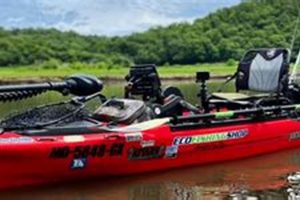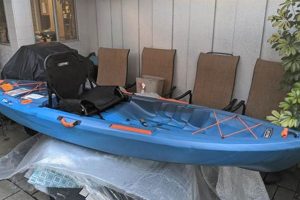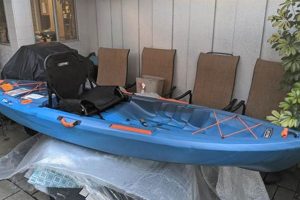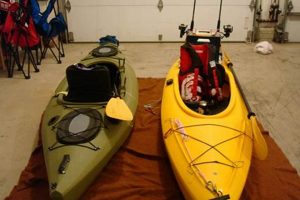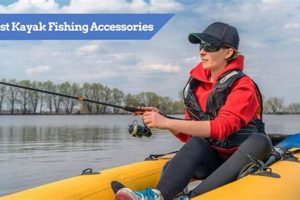Equipment designed specifically for angling from kayaks encompasses a broad range of items, from rod holders and fish finders to specialized seating and storage solutions. For instance, a kayak angler might employ a GPS-enabled fish finder to locate schools of fish, secure rods in specialized holders while paddling, and utilize a livewell to keep catches fresh. These specialized items transform a standard kayak into a dedicated fishing platform.
Enhanced angling success and improved safety and comfort on the water are key advantages provided by these specialized items. Historically, kayak fishing involved adapting general-purpose kayaks with limited specialized gear. The evolution of purpose-built fishing kayaks and accompanying equipment has significantly elevated the sport, allowing anglers to access previously unreachable fishing grounds and employ techniques tailored to this unique watercraft. This specialized gear plays a vital role in optimizing both fishing effectiveness and the overall kayaking experience.
A detailed examination of individual equipment categories, selection criteria, and proper usage will further illuminate the critical role these specialized items play in modern kayak angling.
Essential Equipment Tips for Kayak Angling
Careful equipment selection significantly impacts kayak fishing success and safety. These tips offer guidance for optimizing gear choices.
Tip 1: Prioritize Stability and Comfort. Kayak selection should precede other equipment choices. A stable, comfortable platform is essential, particularly for longer outings. Consider kayak width, hull design, and seating adjustments when making a selection.
Tip 2: Choose Appropriate Rod Holders. Rod holders free hands for paddling and other tasks. Flush-mount, adjustable, and rotating rod holders cater to different fishing styles and rod types. Secure placement prevents rod loss and interference.
Tip 3: Invest in a Reliable Fish Finder. Fish finders locate fish and identify underwater structures. GPS-enabled models aid navigation and mark productive fishing spots. Choose a unit with a clear display and appropriate transducer for the fishing environment.
Tip 4: Employ Efficient Storage Solutions. Tackle boxes, dry bags, and dedicated storage compartments keep gear organized and protected. Proper storage maximizes space and prevents gear loss or damage.
Tip 5: Enhance Safety with Essential Gear. A personal flotation device (PFD) is paramount. A whistle, signaling mirror, and first-aid kit are crucial safety additions. Navigation lights are essential for low-light conditions.
Tip 6: Consider a Kayak Anchor or Stake-Out Pole. Maintaining position in current or wind enhances fishing effectiveness. Anchors and stake-out poles provide stability in shallow water environments.
Tip 7: Select Appropriate Paddle and Leash. A lightweight, efficient paddle minimizes fatigue. A paddle leash prevents loss in the event of a capsize. Choose a leash length suited to the kayak’s size.
Strategic gear choices maximize efficiency and safety on the water. Properly selected and utilized, equipment significantly enhances the overall kayak angling experience.
By following these tips, anglers can effectively equip themselves for successful and enjoyable kayak fishing adventures.
1. Rod Holders
Rod holders are integral components of fishing kayak setups, significantly influencing angling effectiveness and overall kayak organization. They provide secure storage for rods, freeing hands for paddling, landing fish, and other essential tasks. Effective rod holder selection and placement enhance fishing success and contribute to a safer, more streamlined kayaking experience.
- Types and Mounting Options
Various rod holder designs cater to diverse fishing styles and kayak configurations. Flush-mount rod holders integrate seamlessly with the kayak’s deck, minimizing interference while paddling. Adjustable rod holders offer flexibility in rod positioning, accommodating different angling techniques. Track-mounted systems provide customizable placement along the kayak’s gunwales. Selecting appropriate mounting locations and holder types optimizes rod accessibility and minimizes line tangling.
- Material and Construction
Rod holders are typically constructed from durable, corrosion-resistant materials like plastic, aluminum, or stainless steel. High-quality materials withstand the harsh marine environment and ensure long-term performance. Reinforced construction and secure mounting hardware provide stability and prevent rod holder failure under stress.
- Placement and Configuration
Strategic rod holder placement maximizes fishing efficiency and minimizes interference with paddling and other onboard activities. Positioning holders within easy reach allows for quick access to rods while maintaining a balanced kayak. Anglers often utilize multiple rod holders to accommodate different rod types or fishing techniques. Careful consideration of kayak layout and fishing style optimizes rod holder placement.
- Integration with Other Accessories
Rod holders often integrate with other fishing kayak accessories, such as fish finders and tackle storage systems. This integration streamlines workflow and enhances overall fishing efficiency. For example, positioning rod holders near a fish finder display allows anglers to monitor readings while keeping rods readily accessible. Integrating rod holders with tackle storage systems simplifies lure and bait retrieval.
Proper rod holder selection and integration contribute significantly to a well-equipped fishing kayak. By considering factors such as mounting options, material construction, placement, and compatibility with other accessories, anglers can optimize their kayak setup for enhanced fishing performance and overall enjoyment on the water.
2. Fish Finders
Fish finders represent a crucial component within the broader category of fishing kayak accessories. Their integration directly impacts angling success by providing real-time information about underwater environments. This information, including water depth, bottom structure, and fish location, allows anglers to make informed decisions regarding lure selection, fishing technique, and kayak positioning. For example, identifying a submerged rock pile or drop-off allows anglers to target specific areas likely to hold fish. Without a fish finder, locating such features relies heavily on guesswork and prior knowledge of the fishing area. The ability to interpret fish finder data significantly improves angling efficiency, particularly in unfamiliar waters.
Technological advancements have led to sophisticated fish finders with features like GPS mapping, side-imaging, and down-imaging sonar. GPS mapping allows anglers to mark productive fishing spots, track their movements on the water, and navigate to specific locations. Side-imaging and down-imaging sonar provide detailed images of the underwater environment, revealing structures and fish with remarkable clarity. These advanced features significantly enhance situational awareness and angling effectiveness. Connecting fish finders to other kayak accessories, such as trolling motors and chart plotters, further expands their utility. This interconnectedness creates a comprehensive system for locating, targeting, and catching fish.
Selecting and utilizing a fish finder appropriate for kayak fishing requires careful consideration. Compact, portable units designed for kayak mounting are essential. Transducer selection depends on the fishing environment and target species. Understanding fish finder displays and interpreting sonar readings maximizes the benefits of this technology. Effective utilization of fish finders directly translates to increased angling success and contributes significantly to the overall value of a well-equipped fishing kayak.
3. Kayak Storage
Kayak storage represents a critical aspect of fishing kayak accessories, directly impacting angling efficiency, safety, and overall enjoyment. Effective storage solutions maintain organization, protect equipment from damage, and maximize available space within the limited confines of a kayak. A well-organized kayak allows anglers to focus on fishing rather than searching for misplaced gear. For example, readily accessible tackle boxes and lure organizers streamline lure changes and prevent wasted fishing time. Proper storage of safety equipment, such as PFDs and signaling devices, ensures quick access in emergency situations. Conversely, inadequate storage can lead to tangled lines, lost gear, and compromised stability, negatively affecting both fishing success and safety.
Several storage options cater specifically to kayak angling. Dedicated tackle storage systems integrate seamlessly with kayak designs, maximizing space utilization and providing quick access to essential gear. Dry bags and waterproof containers protect sensitive electronics and personal items from water damage. Specialized compartments within the kayak hull accommodate larger items such as rods, paddles, and anchors. Proper weight distribution within storage compartments contributes to kayak stability and maneuverability. Strategic placement of frequently used items within easy reach further enhances angling efficiency. Integrating storage solutions with other fishing kayak accessories, such as rod holders and fish finders, optimizes overall kayak organization and workflow.
Understanding the importance of kayak storage as a component of fishing kayak accessories contributes significantly to a successful and enjoyable angling experience. Effective storage solutions enhance fishing efficiency, maintain safety, and minimize clutter, allowing anglers to focus on the task at hand. Careful consideration of storage needs and selection of appropriate storage options leads to a well-organized and functional fishing kayak setup.
4. Safety Equipment
Safety equipment constitutes a critical subset of fishing kayak accessories, directly impacting angler well-being and emergency preparedness. While specialized fishing gear enhances angling success, safety equipment safeguards against inherent risks associated with on-water activities. Understanding and utilizing appropriate safety equipment is paramount for responsible kayak angling.
- Personal Flotation Devices (PFDs)
PFDs are fundamental safety items for any on-water activity, including kayak fishing. They provide buoyancy in the event of capsizing or accidental immersion, significantly increasing survival chances. Selecting a comfortable, well-fitting PFD designed for kayaking ensures unrestricted movement while paddling and fishing. Inflatable PFDs offer a less bulky alternative but require regular maintenance and inspection.
- Signaling Devices
Signaling devices facilitate communication in emergency situations. A whistle alerts nearby boaters or individuals on shore to potential distress. Visual signals, such as a mirror or flare, enhance visibility over long distances. Carrying a waterproof VHF radio enables direct communication with the Coast Guard and other vessels. Regularly testing signaling devices ensures functionality when needed.
- First-Aid Kit and Emergency Supplies
A well-stocked first-aid kit addresses minor injuries and provides essential supplies in emergency situations. Waterproof packaging protects contents from water damage. Including items like sunscreen, insect repellent, and a basic repair kit further enhances preparedness. Regularly replenishing used supplies maintains kit readiness.
- Navigation Lights and Visibility Aids
Navigation lights and reflective tape enhance kayak visibility, particularly during low-light conditions or periods of reduced visibility. These aids alert other boaters to the kayak’s presence, reducing the risk of collision. Attaching lights to the kayak’s bow and stern ensures visibility from all directions. Brightly colored clothing and accessories further enhance visibility during daylight hours.
Prioritizing safety equipment selection and usage elevates responsible kayak angling practices. Integrating these essential items within the broader framework of fishing kayak accessories ensures angler preparedness and mitigates potential risks associated with on-water activities. A comprehensive approach to safety enhances both the enjoyment and security of kayak fishing experiences.
Navigation aids represent essential components within the fishing kayak accessories category, directly impacting angler safety and fishing effectiveness. These tools facilitate precise positioning, efficient route planning, and safe navigation, particularly in unfamiliar waters or challenging conditions. Consider a scenario where an angler ventures into a complex estuary system. Without navigational aids, disorientation and difficulty returning to the launch point become significant risks. A GPS unit, coupled with a chart plotter, provides real-time location information, tracks movement, and guides the angler safely through the waterway. This capability significantly enhances both fishing success and overall safety. Furthermore, navigation aids assist in locating specific fishing spots identified through research or previous experience. Marking waypoints on a GPS allows anglers to return to productive areas efficiently, maximizing fishing time and minimizing unproductive searching.
Beyond basic GPS functionality, modern navigation aids offer features tailored to kayak angling. Integration with fish finders displays navigation data alongside sonar readings, providing a comprehensive view of the underwater environment and the kayak’s position relative to it. Some units offer tide charts, current information, and weather forecasts, further enhancing situational awareness and safety. Integration with smartphone apps allows anglers to plan routes, share location data with others, and access real-time weather updates. These advanced features transform navigation aids from simple positioning tools into comprehensive information hubs, empowering anglers with knowledge and enhancing their on-water experience.
Understanding the crucial role of navigation aids within the broader context of fishing kayak accessories contributes significantly to informed equipment selection and safe angling practices. Effective utilization of these tools enhances fishing efficiency, mitigates navigational challenges, and promotes safe exploration of diverse aquatic environments. By integrating navigation aids into their kayak setups, anglers prioritize safety, optimize fishing strategies, and gain valuable insights into the waters they navigate.
Frequently Asked Questions
Addressing common inquiries regarding specialized equipment for kayak angling provides clarity and facilitates informed purchasing decisions.
Question 1: What are the most essential accessories for a fishing kayak?
Essential equipment includes a personal flotation device (PFD), paddle leash, rod holders, and a basic first-aid kit. Additional accessories, such as a fish finder, anchor, and specialized storage, enhance angling effectiveness and convenience.
Question 2: How does one choose the right rod holders for a kayak?
Rod holder selection depends on fishing style, rod type, and kayak configuration. Flush-mount holders minimize interference while paddling, while adjustable holders offer versatility. Track-mounted systems allow for customizable placement.
Question 3: What are the benefits of using a fish finder in a kayak?
Fish finders locate fish, identify underwater structures, and provide crucial depth information. GPS-enabled models aid navigation and mark productive fishing locations, enhancing angling efficiency.
Question 4: How can kayak storage be optimized for fishing?
Specialized tackle storage systems, dry bags, and dedicated compartments maximize space utilization and protect gear from water damage. Proper weight distribution within storage compartments contributes to kayak stability.
Question 5: What safety precautions should kayak anglers observe?
Always wear a PFD, carry signaling devices, inform someone of fishing plans, and be aware of weather conditions. Regularly inspect safety equipment and ensure familiarity with its operation.
Question 6: How do navigation aids contribute to kayak fishing?
GPS units and chart plotters assist in locating fishing spots, tracking kayak movement, and navigating safely, particularly in unfamiliar waters. Integration with fish finders and other electronics enhances situational awareness.
Careful consideration of individual needs and fishing environments informs effective equipment selection and contributes significantly to successful and safe kayak angling experiences.
Further exploration of specific accessory categories and product reviews provides additional guidance in equipping a fishing kayak.
Fishing Kayaks Accessories
Specialized equipment designed for kayak angling significantly impacts fishing success and overall safety on the water. From rod holders and fish finders to storage solutions and navigation aids, each component plays a crucial role in optimizing kayak setups for specific fishing styles and environments. Proper equipment selection, informed by careful consideration of individual needs and target species, empowers anglers to maximize efficiency, enhance safety, and improve overall fishing outcomes. The evolution of specialized gear transforms standard kayaks into efficient, purpose-driven fishing platforms, expanding angling opportunities and improving experiences on the water.
Strategic equipment acquisition represents an investment in both angling performance and on-water safety. Continuous exploration of advancements in kayak fishing technology and a commitment to responsible angling practices contribute to a more productive and fulfilling pursuit of this dynamic sport.


